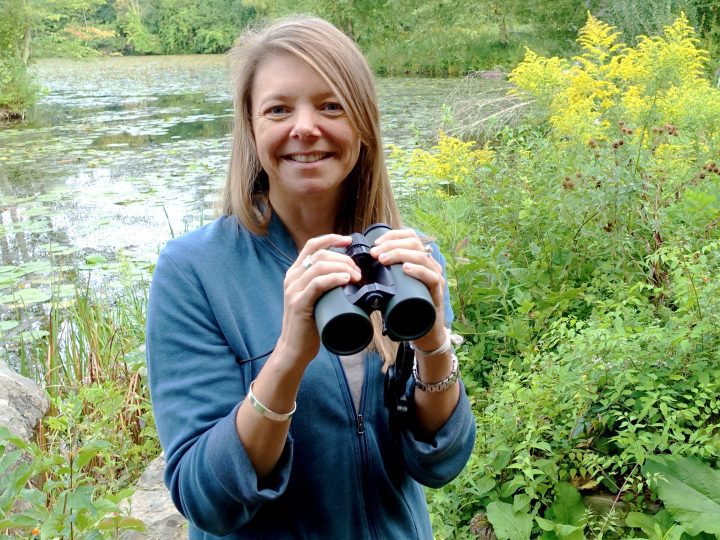Expertise
Science Communication • Bird Identification • Breeding Biology • Avian Conservation • Bird Song • Wildlife Restoration Ecology
My work focuses on engaging people in science, birds, and nature. My love of birds and the natural world drives me to share my passions to educate and inspire. To that end, I manage and coordinate the Cornell Lab’s communications, helping us maximize our impact to reverse pervasive bird declines. I love writing and talking about science, helping people see the amazing things in our world, and I am lucky enough to be able to do that every day.
My love of nature blossomed from early camping trips with my family. Those early experiences led me to study conservation biology with a focus on plants as an undergraduate. It wasn’t until I took an ornithology course during my senior year that I became hooked on birds. Since then, I have traveled the world studying, watching, and recording birds from the Sierra Nevada mountains to the Chihuahuan Desert, and from the rainforests to the cloud forests in Central and South America.
During my Masters, I examined the effects of non-native plants on nesting success of birds in rural and urban landscapes. This work allowed me to combine my love of plants and birds to examine how human changes to the environment impact songbirds. My Ph.D. took me to the Sierra Nevada mountains where I led a wildlife restoration project. I worked with the U.S. Forest Service to restore mountain meadows and creeks for wildlife. I also examined the effects that seasonal changes in the environment can have on the nesting success of songbirds for my Ph.D.
Throughout it all, studying bird song has been a core love of mine. I eventually found my way to recording bird song thanks to the Macaulay Library. I recorded the vocalizations of birds throughout Central and South America, digging even deeper into bird song.
Now I am fortunate to share my experiences and passion with the world.
Education
Ph.D., Ornithology, University of Arizona
M.S., Ornithology, Ohio State University
B.A., Biological Conservation and Anthropology, University of Wisconsin, Madison
Favorite Bird
I love antpittas. There is almost nothing better than watching an antpitta sing.
Recent Publications
2804417
Borgmann
items
1
10
date
desc
title
2889
https://www.birds.cornell.edu/home/wp-content/plugins/zotpress/
%7B%22status%22%3A%22success%22%2C%22updateneeded%22%3Afalse%2C%22instance%22%3A%22zotpress-bd23ee8ac8c42e997ef9adb4b160e24b%22%2C%22meta%22%3A%7B%22request_last%22%3A0%2C%22request_next%22%3A0%2C%22used_cache%22%3Atrue%7D%2C%22data%22%3A%5B%7B%22key%22%3A%2262LT9TE3%22%2C%22library%22%3A%7B%22id%22%3A2804417%7D%2C%22meta%22%3A%7B%22creatorSummary%22%3A%22Borgmann%22%2C%22parsedDate%22%3A%222020-08%22%2C%22numChildren%22%3A0%7D%2C%22bib%22%3A%22%3Cdiv%20class%3D%5C%22csl-bib-body%5C%22%20style%3D%5C%22line-height%3A%201.35%3B%20padding-left%3A%201em%3B%20text-indent%3A-1em%3B%5C%22%3E%5Cn%20%20%3Cdiv%20class%3D%5C%22csl-entry%5C%22%3EBorgmann%2C%20K.%20%282020%29.%20Best%20Practices%20for%20Recording%20Birdsong%3A%20Sound%20Advice%20from%20the%20Folks%20at%20the%20Macaulay%20Library.%20%3Ci%3EBirding%20Magazine%20Online%3C%5C%2Fi%3E.%3C%5C%2Fdiv%3E%5Cn%3C%5C%2Fdiv%3E%22%2C%22data%22%3A%7B%22itemType%22%3A%22blogPost%22%2C%22title%22%3A%22Best%20Practices%20for%20Recording%20Birdsong%3A%20Sound%20Advice%20from%20the%20Folks%20at%20the%20Macaulay%20Library%22%2C%22creators%22%3A%5B%7B%22creatorType%22%3A%22author%22%2C%22firstName%22%3A%22Kathi%22%2C%22lastName%22%3A%22Borgmann%22%7D%5D%2C%22abstractNote%22%3A%22%22%2C%22blogTitle%22%3A%22Birding%20Magazine%20Online%22%2C%22date%22%3A%22August%202020%22%2C%22url%22%3A%22%22%2C%22language%22%3A%22%22%2C%22collections%22%3A%5B%22GC4XKNTH%22%5D%2C%22dateModified%22%3A%222023-05-19T18%3A32%3A48Z%22%7D%7D%2C%7B%22key%22%3A%224JT3H8JR%22%2C%22library%22%3A%7B%22id%22%3A2804417%7D%2C%22meta%22%3A%7B%22creatorSummary%22%3A%22Borgmann%22%2C%22parsedDate%22%3A%222019-01-30%22%2C%22numChildren%22%3A0%7D%2C%22bib%22%3A%22%3Cdiv%20class%3D%5C%22csl-bib-body%5C%22%20style%3D%5C%22line-height%3A%201.35%3B%20padding-left%3A%201em%3B%20text-indent%3A-1em%3B%5C%22%3E%5Cn%20%20%3Cdiv%20class%3D%5C%22csl-entry%5C%22%3EBorgmann%2C%20K.%20%282019%29.%20Mechanisms%20underlying%20intra-seasonal%20variation%20in%20the%20risk%20of%20avian%20nest%20predation%3A%20implications%20for%20breeding%20phenology.%3C%5C%2Fdiv%3E%5Cn%3C%5C%2Fdiv%3E%22%2C%22data%22%3A%7B%22itemType%22%3A%22journalArticle%22%2C%22title%22%3A%22Mechanisms%20underlying%20intra-seasonal%20variation%20in%20the%20risk%20of%20avian%20nest%20predation%3A%20implications%20for%20breeding%20phenology%22%2C%22creators%22%3A%5B%7B%22creatorType%22%3A%22author%22%2C%22firstName%22%3A%22Kathi%22%2C%22lastName%22%3A%22Borgmann%22%7D%5D%2C%22abstractNote%22%3A%22%22%2C%22date%22%3A%22January%2030%2C%202019%22%2C%22language%22%3A%22%22%2C%22DOI%22%3A%22%22%2C%22ISSN%22%3A%22%22%2C%22url%22%3A%22%22%2C%22collections%22%3A%5B%22IXIURSY5%22%2C%22QZ2EYAGN%22%5D%2C%22dateModified%22%3A%222020-04-07T23%3A43%3A53Z%22%7D%7D%2C%7B%22key%22%3A%227DUMT2YL%22%2C%22library%22%3A%7B%22id%22%3A2804417%7D%2C%22meta%22%3A%7B%22creatorSummary%22%3A%22Glisson%20et%20al.%22%2C%22parsedDate%22%3A%222017-06-01%22%2C%22numChildren%22%3A0%7D%2C%22bib%22%3A%22%3Cdiv%20class%3D%5C%22csl-bib-body%5C%22%20style%3D%5C%22line-height%3A%201.35%3B%20padding-left%3A%201em%3B%20text-indent%3A-1em%3B%5C%22%3E%5Cn%20%20%3Cdiv%20class%3D%5C%22csl-entry%5C%22%3EGlisson%2C%20W.%2C%20C.%20Conway%2C%20C.%20Nadeau%2C%20and%20K.%20Borgmann%20%282017%29.%20Habitat%20models%20to%20predict%20wetland%20bird%20occupancy%20in%26%23xFB02%3Buenced%20by%20scale%2C%20anthropogenic%20disturbance%2C%20and%20imperfect%20detection.%3C%5C%2Fdiv%3E%5Cn%3C%5C%2Fdiv%3E%22%2C%22data%22%3A%7B%22itemType%22%3A%22book%22%2C%22title%22%3A%22Habitat%20models%20to%20predict%20wetland%20bird%20occupancy%20in%5Cufb02uenced%20by%20scale%2C%20anthropogenic%20disturbance%2C%20and%20imperfect%20detection%22%2C%22creators%22%3A%5B%7B%22creatorType%22%3A%22author%22%2C%22firstName%22%3A%22Wesley%22%2C%22lastName%22%3A%22Glisson%22%7D%2C%7B%22creatorType%22%3A%22author%22%2C%22firstName%22%3A%22Courtney%22%2C%22lastName%22%3A%22Conway%22%7D%2C%7B%22creatorType%22%3A%22author%22%2C%22firstName%22%3A%22Chris%22%2C%22lastName%22%3A%22Nadeau%22%7D%2C%7B%22creatorType%22%3A%22author%22%2C%22firstName%22%3A%22Kathi%22%2C%22lastName%22%3A%22Borgmann%22%7D%5D%2C%22abstractNote%22%3A%22%22%2C%22date%22%3A%22June%201%2C%202017%22%2C%22language%22%3A%22%22%2C%22ISBN%22%3A%22%22%2C%22url%22%3A%22%22%2C%22collections%22%3A%5B%22AZC8I8RJ%22%5D%2C%22dateModified%22%3A%222020-04-07T23%3A43%3A53Z%22%7D%7D%2C%7B%22key%22%3A%22Z2TIXU5X%22%2C%22library%22%3A%7B%22id%22%3A2804417%7D%2C%22meta%22%3A%7B%22creatorSummary%22%3A%22Borgmann%20and%20Conway%22%2C%22parsedDate%22%3A%222015-12-01%22%2C%22numChildren%22%3A0%7D%2C%22bib%22%3A%22%3Cdiv%20class%3D%5C%22csl-bib-body%5C%22%20style%3D%5C%22line-height%3A%201.35%3B%20padding-left%3A%201em%3B%20text-indent%3A-1em%3B%5C%22%3E%5Cn%20%20%3Cdiv%20class%3D%5C%22csl-entry%5C%22%3EBorgmann%2C%20K.%2C%20and%20C.%20Conway%20%282015%29.%20The%20Nest-Concealment%20Hypothesis%3A%20New%20Insights%20from%20a%20Comparative%20Analysis.%20Wilson%20Journal%20of%20Ornithology%20127%3A646%26%23x2013%3B660.%3C%5C%2Fdiv%3E%5Cn%3C%5C%2Fdiv%3E%22%2C%22data%22%3A%7B%22itemType%22%3A%22journalArticle%22%2C%22title%22%3A%22The%20Nest-Concealment%20Hypothesis%3A%20New%20Insights%20from%20a%20Comparative%20Analysis%22%2C%22creators%22%3A%5B%7B%22creatorType%22%3A%22author%22%2C%22firstName%22%3A%22Kathi%22%2C%22lastName%22%3A%22Borgmann%22%7D%2C%7B%22creatorType%22%3A%22author%22%2C%22firstName%22%3A%22Courtney%22%2C%22lastName%22%3A%22Conway%22%7D%5D%2C%22abstractNote%22%3A%22Selection%20of%20a%20breeding%20site%20is%20critical%20for%20many%20animals%2C%20especially%20for%20birds%20whose%20offspring%20are%20stationary%20during%20development.%20Thus%2C%20birds%20are%20often%20assumed%20to%20prefer%20concealed%20nest%20sites.%20However%2C%2074%25%20of%20studies%20%28n%20%3D%20106%29%20that%20have%20evaluated%20this%20relationship%20for%20open-cup%20nesting%20songbirds%20in%20North%20America%20failed%20to%20support%20the%20nest-concealment%20hypothesis.%20We%20conducted%20a%20comparative%20analysis%20to%20identify%20factors%20that%20contribute%20to%20variation%20in%20the%20ability%20of%20researchers%20to%20find%20support%20for%20the%20nest-concealment%20hypothesis.%20We%20found%20that%20some%20of%20the%20discrepancy%20among%20studies%20can%20be%20explained%20by%20interspecific%20differences%20in%20morphological%20and%20extrinsic%20factors%20that%20affect%20nest%20predation.%20Moreover%2C%20methods%20that%20investigators%20used%20to%20estimate%20concealment%20affected%20whether%20studies%20found%20support%20for%20the%20nest-concealment%20hypothesis%3B%2033%25%20of%20the%20studies%20that%20used%20quantitative%20estimates%20found%20support%20for%20the%20nest-concealment%20hypothesis%20whereas%20only%2010%25%20of%20the%20studies%20that%20used%20qualitative%20estimates%20found%20support.%20The%20timing%20of%20measurements%20also%20explained%20some%20of%20the%20ambiguity%3B%20studies%20that%20provided%20little%20information%20regarding%20the%20timing%20of%20their%20foliage%20density%20estimates%20were%20less%20likely%20to%20support%20the%20nest-concealment%20hypothesis.%20Species%20with%20more%20conspicuous%20male%20plumage%20were%20less%20likely%20to%20support%20the%20nest-concealment%20hypothesis%20when%20we%20analyzed%20studies%20that%20used%20visual%20estimates.%20Whereas%20species%20with%20more%20conspicuous%20female%20plumage%20were%20more%20likely%20to%20support%20the%20nest-concealment%20hypothesis%20when%20we%20analyzed%20studies%20that%20used%20quantitative%20measures.%20Our%20results%20demonstrate%20that%20support%20for%20the%20nest-concealment%20hypothesis%20has%20been%20equivocal%2C%20but%20that%20some%20of%20the%20ambiguity%20can%20be%20explained%20by%20morphological%20traits%20and%20methods%20used%20to%20measure%20concealment.%22%2C%22date%22%3A%22December%201%2C%202015%22%2C%22language%22%3A%22%22%2C%22DOI%22%3A%2210.1676%5C%2F14-162.1%22%2C%22ISSN%22%3A%22%22%2C%22url%22%3A%22%22%2C%22collections%22%3A%5B%22TE6X9TP3%22%5D%2C%22dateModified%22%3A%222020-04-07T23%3A43%3A53Z%22%7D%7D%2C%7B%22key%22%3A%223ADUAMD6%22%2C%22library%22%3A%7B%22id%22%3A2804417%7D%2C%22meta%22%3A%7B%22creatorSummary%22%3A%22Glisson%20et%20al.%22%2C%22parsedDate%22%3A%222015-05-28%22%2C%22numChildren%22%3A0%7D%2C%22bib%22%3A%22%3Cdiv%20class%3D%5C%22csl-bib-body%5C%22%20style%3D%5C%22line-height%3A%201.35%3B%20padding-left%3A%201em%3B%20text-indent%3A-1em%3B%5C%22%3E%5Cn%20%20%3Cdiv%20class%3D%5C%22csl-entry%5C%22%3EGlisson%2C%20W.%2C%20C.%20Conway%2C%20C.%20Nadeau%2C%20K.%20Borgmann%2C%20and%20T.%20A.%20Laxson%20%282015%29.%20Range-wide%20Wetland%20Associations%20of%20the%20King%20Rail%3A%20A%20Multi-scale%20Approach.%20Wetlands%2035%3A577%26%23x2013%3B587.%3C%5C%2Fdiv%3E%5Cn%3C%5C%2Fdiv%3E%22%2C%22data%22%3A%7B%22itemType%22%3A%22journalArticle%22%2C%22title%22%3A%22Range-wide%20Wetland%20Associations%20of%20the%20King%20Rail%3A%20A%20Multi-scale%20Approach%22%2C%22creators%22%3A%5B%7B%22creatorType%22%3A%22author%22%2C%22firstName%22%3A%22Wesley%22%2C%22lastName%22%3A%22Glisson%22%7D%2C%7B%22creatorType%22%3A%22author%22%2C%22firstName%22%3A%22Courtney%22%2C%22lastName%22%3A%22Conway%22%7D%2C%7B%22creatorType%22%3A%22author%22%2C%22firstName%22%3A%22Chris%22%2C%22lastName%22%3A%22Nadeau%22%7D%2C%7B%22creatorType%22%3A%22author%22%2C%22firstName%22%3A%22Kathi%22%2C%22lastName%22%3A%22Borgmann%22%7D%2C%7B%22creatorType%22%3A%22author%22%2C%22firstName%22%3A%22Thomas%22%2C%22lastName%22%3A%22A.%20Laxson%22%7D%5D%2C%22abstractNote%22%3A%22King%20Rail%20populations%20have%20declined%20and%20identifying%20wetland%20features%20that%20influence%20King%20Rail%20occupancy%20can%20help%20prevent%20further%20population%20declines.%20We%20integrated%20continent-wide%20marsh%20bird%20survey%20data%20with%20spatial%20wetland%20data%20from%20the%20National%20Wetland%20Inventory%20%28NWI%29%20to%20examine%20wetland%20features%20that%20influenced%20King%20Rail%20occupancy%20throughout%20the%20species%5Cu2019%20range.%20We%20analyzed%20wetland%20data%20at%207%20spatial%20scales%20to%20examine%20the%20scale%28s%29%20at%20which%2068%20wetland%20features%20were%20most%20strongly%20related%20to%20King%20Rail%20occupancy.%20Occupancy%20was%20most%20strongly%20associated%20with%20estuarine%20features%20and%20brackish%20and%20tidal%20saltwater%20regimes.%20King%20Rail%20occupancy%20was%20positively%20associated%20with%20emergent%20and%20scrub-shrub%20wetlands%20and%20negatively%20associated%20with%20forested%20wetlands.%20The%20best%20spatial%20scale%20for%20assessing%20King%20Rail%20occupancy%20differed%20among%20wetland%20features%3B%20we%20could%20not%20identify%20one%20spatial%20scale%20%28among%20all%20wetland%20features%29%20that%20best%20explained%20variation%20in%20occupancy.%20Future%20research%20on%20King%20Rail%20habitat%20that%20includes%20multiple%20spatial%20scales%20is%20more%20likely%20to%20identify%20the%20suite%20of%20features%20that%20influence%20occupancy.%20Our%20results%20indicate%20that%20NWI%20data%20may%20be%20useful%20for%20predicting%20occupancy%20based%20on%20broad%20habitat%20features%20across%20the%20King%20Rail%5Cu2019s%20range%2C%20which%20may%20help%20inform%20management%20decisions%20for%20this%20and%20other%20wetland-dependent%20birds.%22%2C%22date%22%3A%22May%2028%2C%202015%22%2C%22language%22%3A%22%22%2C%22DOI%22%3A%2210.1007%5C%2Fs13157-015-0648-0%22%2C%22ISSN%22%3A%22%22%2C%22url%22%3A%22%22%2C%22collections%22%3A%5B%22TE6X9TP3%22%5D%2C%22dateModified%22%3A%222020-04-07T23%3A43%3A53Z%22%7D%7D%2C%7B%22key%22%3A%224FSXXC5M%22%2C%22library%22%3A%7B%22id%22%3A2804417%7D%2C%22meta%22%3A%7B%22creatorSummary%22%3A%22Borgmann%20and%20Conway%22%2C%22parsedDate%22%3A%222015-01-01%22%2C%22numChildren%22%3A0%7D%2C%22bib%22%3A%22%3Cdiv%20class%3D%5C%22csl-bib-body%5C%22%20style%3D%5C%22line-height%3A%201.35%3B%20padding-left%3A%201em%3B%20text-indent%3A-1em%3B%5C%22%3E%5Cn%20%20%3Cdiv%20class%3D%5C%22csl-entry%5C%22%3EBorgmann%2C%20K.%2C%20and%20C.%20Conway%20%282015%29.%20Wildlife%20habitat%20restoration.%20In%20Wildlife%20Habitat%20Conservation%3A%20Concepts%2C%20Challenges%2C%20and%20Solutions.%20pp.%20157%26%23x2013%3B168.%3C%5C%2Fdiv%3E%5Cn%3C%5C%2Fdiv%3E%22%2C%22data%22%3A%7B%22itemType%22%3A%22bookSection%22%2C%22title%22%3A%22Wildlife%20habitat%20restoration%22%2C%22creators%22%3A%5B%7B%22creatorType%22%3A%22author%22%2C%22firstName%22%3A%22Kathi%22%2C%22lastName%22%3A%22Borgmann%22%7D%2C%7B%22creatorType%22%3A%22author%22%2C%22firstName%22%3A%22Courtney%22%2C%22lastName%22%3A%22Conway%22%7D%5D%2C%22abstractNote%22%3A%22%22%2C%22bookTitle%22%3A%22Wildlife%20Habitat%20Conservation%3A%20Concepts%2C%20Challenges%2C%20and%20Solutions%22%2C%22date%22%3A%22January%201%2C%202015%22%2C%22language%22%3A%22%22%2C%22ISBN%22%3A%22%22%2C%22url%22%3A%22%22%2C%22collections%22%3A%5B%22TE6X9TP3%22%5D%2C%22dateModified%22%3A%222020-04-07T23%3A43%3A53Z%22%7D%7D%2C%7B%22key%22%3A%22WNRZL67H%22%2C%22library%22%3A%7B%22id%22%3A2804417%7D%2C%22meta%22%3A%7B%22creatorSummary%22%3A%22Borgmann%20et%20al.%22%2C%22parsedDate%22%3A%222013-06-12%22%2C%22numChildren%22%3A0%7D%2C%22bib%22%3A%22%3Cdiv%20class%3D%5C%22csl-bib-body%5C%22%20style%3D%5C%22line-height%3A%201.35%3B%20padding-left%3A%201em%3B%20text-indent%3A-1em%3B%5C%22%3E%5Cn%20%20%3Cdiv%20class%3D%5C%22csl-entry%5C%22%3EBorgmann%2C%20K.%2C%20C.%20Conway%2C%20and%20M.%20L%20Morrison%20%282013%29.%20Breeding%20Phenology%20of%20Birds%3A%20Mechanisms%20Underlying%20Seasonal%20Declines%20in%20the%20Risk%20of%20Nest%20Predation.%20PLOS%20ONE%208%3A1%26%23x2013%3B10.%3C%5C%2Fdiv%3E%5Cn%3C%5C%2Fdiv%3E%22%2C%22data%22%3A%7B%22itemType%22%3A%22journalArticle%22%2C%22title%22%3A%22Breeding%20Phenology%20of%20Birds%3A%20Mechanisms%20Underlying%20Seasonal%20Declines%20in%20the%20Risk%20of%20Nest%20Predation%22%2C%22creators%22%3A%5B%7B%22creatorType%22%3A%22author%22%2C%22firstName%22%3A%22Kathi%22%2C%22lastName%22%3A%22Borgmann%22%7D%2C%7B%22creatorType%22%3A%22author%22%2C%22firstName%22%3A%22Courtney%22%2C%22lastName%22%3A%22Conway%22%7D%2C%7B%22creatorType%22%3A%22author%22%2C%22firstName%22%3A%22Michael%22%2C%22lastName%22%3A%22L%20Morrison%22%7D%5D%2C%22abstractNote%22%3A%22Seasonal%20declines%20in%20avian%20clutch%20size%20are%20well%20documented%2C%20but%20seasonal%20variation%20in%20other%20reproductive%20parameters%20has%20received%20less%20attention.%20For%20example%2C%20the%20probability%20of%20complete%20brood%20mortality%20typically%20explains%20much%20of%20the%20variation%20in%20reproductive%20success%20and%20often%20varies%20seasonally%2C%20but%20we%20know%20little%20about%20the%20underlying%20cause%20of%20that%20variation.%20This%20oversight%20is%20surprising%20given%20that%20nest%20predation%20influences%20many%20other%20life-history%20traits%20and%20varies%20throughout%20the%20breeding%20season%20in%20many%20songbirds.%20To%20determine%20the%20underlying%20causes%20of%20observed%20seasonal%20decreases%20in%20risk%20of%20nest%20predation%2C%20we%20modeled%20nest%20predation%20of%20Dusky%20Flycatchers%20%28Empidonax%20oberholseri%29%20in%20northern%20California%20as%20a%20function%20of%20foliage%20phenology%2C%20energetic%20demand%2C%20developmental%20stage%2C%20conspecific%20nest%20density%2C%20food%20availability%20for%20nest%20predators%2C%20and%20nest%20predator%20abundance.%20Seasonal%20variation%20in%20the%20risk%20of%20nest%20predation%20was%20not%20associated%20with%20seasonal%20changes%20in%20energetic%20demand%2C%20conspecific%20nest%20density%2C%20or%20predator%20abundance.%20Instead%2C%20seasonal%20variation%20in%20the%20risk%20of%20nest%20predation%20was%20associated%20with%20foliage%20density%20%28early%2C%20but%20not%20late%2C%20in%20the%20breeding%20season%29%20and%20seasonal%20changes%20in%20food%20available%20to%20nest%20predators.%20Supplemental%20food%20provided%20to%20nest%20predators%20resulted%20in%20a%20numerical%20response%20by%20nest%20predators%2C%20increasing%20the%20risk%20of%20nest%20predation%20at%20nests%20that%20were%20near%20supplemental%20feeders.%20Our%20results%20suggest%20that%20seasonal%20changes%20in%20foliage%20density%20and%20factors%20associated%20with%20changes%20in%20food%20availability%20for%20nest%20predators%20are%20important%20drivers%20of%20temporal%20patterns%20in%20risk%20of%20avian%20nest%20predation.%22%2C%22date%22%3A%22June%2012%2C%202013%22%2C%22language%22%3A%22%22%2C%22DOI%22%3A%2210.1371%5C%2Fjournal.pone.0065909%22%2C%22ISSN%22%3A%22%22%2C%22url%22%3A%22%22%2C%22collections%22%3A%5B%22TE6X9TP3%22%5D%2C%22dateModified%22%3A%222020-04-07T23%3A43%3A53Z%22%7D%7D%2C%7B%22key%22%3A%2224KW7UXG%22%2C%22library%22%3A%7B%22id%22%3A2804417%7D%2C%22meta%22%3A%7B%22creatorSummary%22%3A%22Rosenzweig%20et%20al.%22%2C%22parsedDate%22%3A%222012-03-01%22%2C%22numChildren%22%3A1%7D%2C%22bib%22%3A%22%3Cdiv%20class%3D%5C%22csl-bib-body%5C%22%20style%3D%5C%22line-height%3A%201.35%3B%20padding-left%3A%201em%3B%20text-indent%3A-1em%3B%5C%22%3E%5Cn%20%20%3Cdiv%20class%3D%5C%22csl-entry%5C%22%3ERosenzweig%2C%20M.%2C%20F.%20Drumlevitch%2C%20K.%20Borgmann%2C%20A.%20Flesch%2C%20S.%20M%20Grajeda%2C%20G.%20Johnson%2C%20K.%20Mackay%2C%20K.%20Nicholson%2C%20V.%20Patterson%2C%20and%20B.%20M%20Pri-Tal%20%282012%29.%20An%20ecological%20telescope%20to%20view%20future%20terrestrial%20vertebrate%20diversity.%20Evolutionary%20Ecology%20Research%2014%3A247%26%23x2013%3B268.%3C%5C%2Fdiv%3E%5Cn%3C%5C%2Fdiv%3E%22%2C%22data%22%3A%7B%22itemType%22%3A%22journalArticle%22%2C%22title%22%3A%22An%20ecological%20telescope%20to%20view%20future%20terrestrial%20vertebrate%20diversity%22%2C%22creators%22%3A%5B%7B%22creatorType%22%3A%22author%22%2C%22firstName%22%3A%22Michael%22%2C%22lastName%22%3A%22Rosenzweig%22%7D%2C%7B%22creatorType%22%3A%22author%22%2C%22firstName%22%3A%22Fred%22%2C%22lastName%22%3A%22Drumlevitch%22%7D%2C%7B%22creatorType%22%3A%22author%22%2C%22firstName%22%3A%22Kathi%22%2C%22lastName%22%3A%22Borgmann%22%7D%2C%7B%22creatorType%22%3A%22author%22%2C%22firstName%22%3A%22Aaron%22%2C%22lastName%22%3A%22Flesch%22%7D%2C%7B%22creatorType%22%3A%22author%22%2C%22firstName%22%3A%22Susana%22%2C%22lastName%22%3A%22M%20Grajeda%22%7D%2C%7B%22creatorType%22%3A%22author%22%2C%22firstName%22%3A%22Glenn%22%2C%22lastName%22%3A%22Johnson%22%7D%2C%7B%22creatorType%22%3A%22author%22%2C%22firstName%22%3A%22Kelly%22%2C%22lastName%22%3A%22Mackay%22%7D%2C%7B%22creatorType%22%3A%22author%22%2C%22firstName%22%3A%22Kerry%22%2C%22lastName%22%3A%22Nicholson%22%7D%2C%7B%22creatorType%22%3A%22author%22%2C%22firstName%22%3A%22Virginia%22%2C%22lastName%22%3A%22Patterson%22%7D%2C%7B%22creatorType%22%3A%22author%22%2C%22firstName%22%3A%22Benjamin%22%2C%22lastName%22%3A%22M%20Pri-Tal%22%7D%5D%2C%22abstractNote%22%3A%22Background%3A%20Some%20regions%20of%20the%20Earth%20sustain%20their%20own%20diversities%20through%20the%20processes%20of%20speciation%20and%20extinction.%20Theory%20predicts%20and%20data%20support%20the%20conclusion%20that%20the%20number%20of%20species%20%28S%29%20in%20such%20regions%20should%20attain%20a%20steady%20state%20whose%20value%20correlates%20with%20their%20areas%20%28extents%29.%20Other%20data%20strongly%20suggest%20that%20climate%20plays%20a%20significant%20role%20in%20determining%20S.%20Aim%3A%20Combine%20the%20influences%20of%20area%20and%20climate%20in%20a%20mathematical%20model%20that%20fits%20known%20global%20terrestrial%20vertebrate%20species%20diversities.%20Data%3A%20The%20WildFinder%20terrestrial%20vertebrate%20data%20set%20of%20the%20World%20Wildlife%20Fund%20as%20it%20stood%20in%20January%202006%20%28less%20some%20data%20associated%20with%20islands%29.%20Each%20of%20WildFinder%27s%20825%20ecoregions%20is%20accompanied%20by%20a%20set%20of%20abiotic%20variables%20%28area%20and%20values%20of%20climate%20variables%29%2C%20as%20well%20as%20a%20list%20of%20the%20resident%20vertebrate%20species%20it%20contains.%20Methods%3A%20Assign%20each%20ecoregion%20to%20a%20zoological%20region%20%28sensu%20Sclater%2C%201858%29.%20Compile%20a%20list%20of%20all%20species%20that%20reside%20in%20each%20zoological%20region.%20Calculate%20the%20area%20of%20each%20region%20%28A%29%2C%20the%20number%20of%20species%20in%20it%20%28separated%20into%20the%20four%20vertebrate%20classes%3A%20Amphibia%2C%20Reptilia%2C%20Aves%2C%20Mammalia%29.%20Find%20a%20suitable%20variable%20to%20represent%20annual%20energy%20flow%20%28i.e.%20ecological%20productivity%29.%20Determine%20the%20number%20of%20species%20endemic%20to%20each%20zoological%20region.%20Calculate%20the%20mean%20annual%20temperature%20%28T%29%20and%20actual%20evapotranspiration%20%28AE%29%20in%20each%20zoological%20region.%20Find%20the%20regression%20equations%20that%20best%20fit%20the%20numbers%20of%20species.%20Results%3A%20The%20land%20has%20nine%20zoological%20regions%20%28in%20order%20of%20area%29%3A%20Palearctic%2C%20Nearctic%2C%20Sub-Saharan%20Africa%2C%20Neotropics%2C%20Australasia%2C%20Indo-Malaysia%2C%20Madagascar%2C%20New%20Zealand%2C%20and%20Hawaii.%20The%20number%20of%20species%2C%20S%2C%20fits%20area%20%28R2%20%3D0.84%3B%20P%20%3D6%20%5Cu00d710-4%29.%20Neither%20T%20by%20itself%20nor%20AE%20by%20itself%20is%20significantly%20correlated%20with%20S.%20However%2C%20adding%20either%20T%20or%20AE%20as%20the%20second%20variable%20in%20the%20regression%20does%20increase%20R%202%20significantly.%20Their%20statistical%20effects%20on%20R2%20are%20virtually%20identical%3A%20using%20logA%20and%20logAE%20as%20independent%20variables%20yields%20R%202%20%3D0.974%3B%20using%20logA%20and%20T%20yields%20R2%20%3D0.973.%20The%20results%20for%20the%20diversities%20of%20the%20four%20separate%20classes%20are%20quite%20similar%20to%20those%20of%20the%20total%20S%2C%20except%20that%20their%20four%20z-values%20vary%20from%200.53%20to%201.07.%20Conclusion%3A%20The%20Earth%27s%20terrestrial%20vertebrates%20face%20a%20mass%20extinction%20of%2030-96%25.%22%2C%22date%22%3A%22March%201%2C%202012%22%2C%22language%22%3A%22%22%2C%22DOI%22%3A%22%22%2C%22ISSN%22%3A%22%22%2C%22url%22%3A%22%22%2C%22collections%22%3A%5B%22TE6X9TP3%22%5D%2C%22dateModified%22%3A%222020-04-07T23%3A43%3A53Z%22%7D%7D%2C%7B%22key%22%3A%22NA7LWVMV%22%2C%22library%22%3A%7B%22id%22%3A2804417%7D%2C%22meta%22%3A%7B%22creatorSummary%22%3A%22Borgmann%22%2C%22parsedDate%22%3A%222010-07-26%22%2C%22numChildren%22%3A0%7D%2C%22bib%22%3A%22%3Cdiv%20class%3D%5C%22csl-bib-body%5C%22%20style%3D%5C%22line-height%3A%201.35%3B%20padding-left%3A%201em%3B%20text-indent%3A-1em%3B%5C%22%3E%5Cn%20%20%3Cdiv%20class%3D%5C%22csl-entry%5C%22%3EBorgmann%2C%20K.%20%282010%29.%20Factors%20Influencing%20the%20Frequency%20of%20Nest%20Parasitism%20by%20Brown-Headed%20Cowbirds%20in%20the%20Northern%20Sierra%20Nevada.%20Western%20North%20American%20Naturalist%2070%3A137%26%23x2013%3B143.%3C%5C%2Fdiv%3E%5Cn%3C%5C%2Fdiv%3E%22%2C%22data%22%3A%7B%22itemType%22%3A%22journalArticle%22%2C%22title%22%3A%22Factors%20Influencing%20the%20Frequency%20of%20Nest%20Parasitism%20by%20Brown-Headed%20Cowbirds%20in%20the%20Northern%20Sierra%20Nevada%22%2C%22creators%22%3A%5B%7B%22creatorType%22%3A%22author%22%2C%22firstName%22%3A%22Kathi%22%2C%22lastName%22%3A%22Borgmann%22%7D%5D%2C%22abstractNote%22%3A%22Nest%20parasitism%20by%20Brown-headed%20Cowbirds%20%28Molothrus%20ater%29%20can%20negatively%20affect%20host%20populations.%20Landscape-scale%20factors%2C%20such%20as%20proximity%20to%20residential%20areas%2C%20equestrian%20riding%20stables%2C%20and%20grazing%20allotments%2C%20can%20affect%20the%20risk%20of%20nest%20parasitism%20as%20well%20as%20the%20abundance%20of%20Brown-headed%20Cowbirds%2C%20Recent%20increases%20in%20residential%20and%20recreational%20development%20along%20with%20a%20reduction%20in%20grazing%20allotments%20in%20the%20northern%20Sierra%20Nevada%20provide%20an%20opportunity%20to%20reevaluate%20factors%20that%20influence%20frequency%20of%20nest%20parasitism%20by%20Brown-headed%20Cowbirds%2C%20Frequency%20of%20nest%20parasitism%20increased%20as%20the%20distance%20to%20the%20nearest%20residential%20center%20and%20distance%20to%20the%20nearest%20equestrian%20riding%20stable%20decreased.%20Similarly%2C%20Brown-headed%20Cowbird%20abundance%20was%20negatively%20correlated%20with%20distance%20to%20the%20nearest%20residential%20center%20and%20distance%20to%20the%20nearest%20equestrian%20stable.%20To%20reduce%20the%20risk%20of%20nest%20parasitism%2C%20efforts%20should%20be%20devoted%20to%20%281%29%20reducing%20further%20residential%20development%20at%20the%20wildland%5Cu2014urban%20interface%20and%20%282%29%20educating%20landowners%20about%20bird%20feeders%2C%20which%20frequently%20attract%20Brown-headed%20Cowbirds.%22%2C%22date%22%3A%22July%2026%2C%202010%22%2C%22language%22%3A%22%22%2C%22DOI%22%3A%2210.3398%5C%2F064.070.0201%22%2C%22ISSN%22%3A%22%22%2C%22url%22%3A%22%22%2C%22collections%22%3A%5B%22TE6X9TP3%22%5D%2C%22dateModified%22%3A%222020-04-07T23%3A43%3A53Z%22%7D%7D%2C%7B%22key%22%3A%22TLKIJ6XU%22%2C%22library%22%3A%7B%22id%22%3A2804417%7D%2C%22meta%22%3A%7B%22creatorSummary%22%3A%22Morrison%20et%20al.%22%2C%22parsedDate%22%3A%222010-03%22%2C%22numChildren%22%3A2%7D%2C%22bib%22%3A%22%3Cdiv%20class%3D%5C%22csl-bib-body%5C%22%20style%3D%5C%22line-height%3A%201.35%3B%20padding-left%3A%201em%3B%20text-indent%3A-1em%3B%5C%22%3E%5Cn%20%3Cdiv%20class%3D%5C%22csl-entry%5C%22%3EMorrison%2C%20M.%20L.%2C%20J.%20Groce%2C%20and%20K.%20L.%20Borgmann%20%282010%29.%20%3Ca%20href%3D%27https%3A%5C%2F%5C%2Fbioone.org%5C%2Fjournals%5C%2FNorthwestern-Naturalist%5C%2Fvolume-91%5C%2Fissue-1%5C%2FNWN09-04.1%5C%2FOccurrence-of-Bats-in-Highly-Impacted-Environments--The-Lake%5C%2F10.1898%5C%2FNWN09-04.1.full%27%3EOccurrence%20of%20Bats%20in%20Highly%20Impacted%20Environments%3A%20The%20Lake%20Tahoe%20Basin%3C%5C%2Fa%3E.%20Northwestern%20Naturalist%2091%3A87%5Cu201392.%3C%5C%2Fdiv%3E%5Cn%3C%5C%2Fdiv%3E%22%2C%22data%22%3A%7B%22itemType%22%3A%22journalArticle%22%2C%22title%22%3A%22Occurrence%20of%20Bats%20in%20Highly%20Impacted%20Environments%3A%20The%20Lake%20Tahoe%20Basin%22%2C%22creators%22%3A%5B%7B%22creatorType%22%3A%22author%22%2C%22firstName%22%3A%22Michael%20L.%22%2C%22lastName%22%3A%22Morrison%22%7D%2C%7B%22creatorType%22%3A%22author%22%2C%22firstName%22%3A%22Julie%22%2C%22lastName%22%3A%22Groce%22%7D%2C%7B%22creatorType%22%3A%22author%22%2C%22firstName%22%3A%22Kathi%20L.%22%2C%22lastName%22%3A%22Borgmann%22%7D%5D%2C%22abstractNote%22%3A%22%22%2C%22date%22%3A%222010%5C%2F03%22%2C%22language%22%3A%22%22%2C%22DOI%22%3A%2210.1898%5C%2FNWN09-04.1%22%2C%22ISSN%22%3A%221051-1733%2C%201938-5315%22%2C%22url%22%3A%22https%3A%5C%2F%5C%2Fbioone.org%5C%2Fjournals%5C%2FNorthwestern-Naturalist%5C%2Fvolume-91%5C%2Fissue-1%5C%2FNWN09-04.1%5C%2FOccurrence-of-Bats-in-Highly-Impacted-Environments--The-Lake%5C%2F10.1898%5C%2FNWN09-04.1.full%22%2C%22collections%22%3A%5B%22TE6X9TP3%22%5D%2C%22dateModified%22%3A%222020-04-07T23%3A43%3A53Z%22%7D%7D%5D%7D
Borgmann, K. (2020). Best Practices for Recording Birdsong: Sound Advice from the Folks at the Macaulay Library. Birding Magazine Online.
Borgmann, K. (2019). Mechanisms underlying intra-seasonal variation in the risk of avian nest predation: implications for breeding phenology.
Glisson, W., C. Conway, C. Nadeau, and K. Borgmann (2017). Habitat models to predict wetland bird occupancy influenced by scale, anthropogenic disturbance, and imperfect detection.
Borgmann, K., and C. Conway (2015). The Nest-Concealment Hypothesis: New Insights from a Comparative Analysis. Wilson Journal of Ornithology 127:646–660.
Glisson, W., C. Conway, C. Nadeau, K. Borgmann, and T. A. Laxson (2015). Range-wide Wetland Associations of the King Rail: A Multi-scale Approach. Wetlands 35:577–587.
Borgmann, K., and C. Conway (2015). Wildlife habitat restoration. In Wildlife Habitat Conservation: Concepts, Challenges, and Solutions. pp. 157–168.
Borgmann, K., C. Conway, and M. L Morrison (2013). Breeding Phenology of Birds: Mechanisms Underlying Seasonal Declines in the Risk of Nest Predation. PLOS ONE 8:1–10.
Rosenzweig, M., F. Drumlevitch, K. Borgmann, A. Flesch, S. M Grajeda, G. Johnson, K. Mackay, K. Nicholson, V. Patterson, and B. M Pri-Tal (2012). An ecological telescope to view future terrestrial vertebrate diversity. Evolutionary Ecology Research 14:247–268.
Borgmann, K. (2010). Factors Influencing the Frequency of Nest Parasitism by Brown-Headed Cowbirds in the Northern Sierra Nevada. Western North American Naturalist 70:137–143.
Morrison, M. L., J. Groce, and K. L. Borgmann (2010).
Occurrence of Bats in Highly Impacted Environments: The Lake Tahoe Basin. Northwestern Naturalist 91:87–92.

